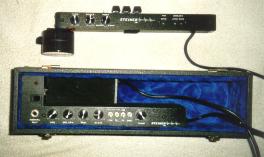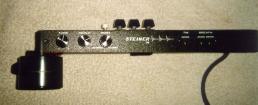Synthacon


above images courtesy of Gab, Amsterdam, The Netherlands.
There is probably no Synthesizer designer that did more for the trumpet player (and woodwind player for that matter) than Nyle Steiner. A trumpet player himself, Nyle was trying to find ways to create an electronic trumpet long before he and Dick Parker started Steiner-Parker.
His early designs did not include synthesizers at all. His idea was to create a electronic string instrument which had valves like a trumpet which shortened and lengthened the string. His idea was to somehow play the harmonics based on this string length, much like a trumpet plays harmonics based on the length of the brass tube. Anyway, luckily he eventually gave up this idea for a better way, and this one involved Synthesizers.
 1972 EVI Prototype 1972 EVI Prototype
image courtesy of Audities Foundation Calgary AB, Canada.
Around 1971, Nyle started working on this new idea. The prototype was finished about a year later, while it was not much to look at (see picture), it worked. The first production models were offered in 1975 with the rest of the Steiner-Parker product line. According to Mr. Steiner, around 200 were produced between 1975 and 1979. Most of them were sold to University electronic music departments and pop groups (one of the first systems was sold to Earth, Wind and Fire).
"The EVI (trumpet like interface) was a shoot off from the modular synths etc. At first I was not real serious about the EVI because I did not know how practical it would actually be. I started experimenting with it because I knew how to make the circuit work and I also could not play keyboard very well. It was not until later after a lot of experimenting that I realized that the EVI was worth really putting some energy into. I started experimenting with the EVI in the very early 70's but in about 1978 or so, it had finally evolved into an instrument that could be used at a professional level." - Nyle Steiner
 image courtesy of Audities Foundation Calgary AB, Canada.
image courtesy of Audities Foundation Calgary AB, Canada.
How did they work?
The EVIs had a dedicated synthesizer module. It look to be a single oscillator synthesizer with very simple controls (5 knobs and 4 switches).
The first EVIs outputted a gate and a single control voltage. The gate was triggered by an air pressure sensor in the mouthpiece. Air was not actually blown throught the instrument but throught the mouthpiece which measured the air pressure inside. Just like a trumpet, the harder you blew, the more air pressure was registered. The EVI outputted control voltage based on the keys which were depressed and the position of the cylinder at the end of the instrument. A combination of rotating the cylinder and thumb rollers selected the octave and the notes were selected by the three springed switches on top, positioned similar to a trumpet valves.
By the time Steiner-Parker disolved in 1979, many new and improved features had been incorporated into the EVI, including the ouput of control voltage from the air sensor(for volume), the "bite sensor" (for portamento), a vibrato sensor and even a pitch bending plate retrofitted later by Steiner. Also by the end of the 70's several interfaces had been developed to use the Steiner (as it was called by then) EVI with other commercially available synths and keyboards including an interface for the Mellotron. (So I guess if you wanted to, you could play a "real trumpet" sound on the Mellotron with your electronic trumpet).
Nyle Steiner eventually took his designs to Crumar which produced the Crumar EVI which debuted in 1980. Crumar was reported to have sold around 500 of these units.
Later, in 1986, the EVI (then a MIDI controller) along with it's sister the EWI (Electronic Wind Instrument) was sold to Akai. However in 1996 Akai discontinued the product line.
"I presently produce on a small scale, an updated version of the EVI. It is just a very light controller that puts out midi and can run on a 9v battery. I used to think that the idea of playing the EVI through midi alone into a sound module was absurd because of the limited resolution of midi. Now, however, there are numerous sound modules available that respond very smooth and fast to midi controllers. Playing through midi alone is now a great thing. With these sound modules available, I don't bother any more with sound module designing or building". - Nyle Steiner
[information from: Ron Cole's doctoral dissertation, "The Electronic Valve Instrument: Nyle Steiner's Unique Musical Innovation," (submitted to the University of Washington in June of 1998), additional information from Nyle steiner]
| 
